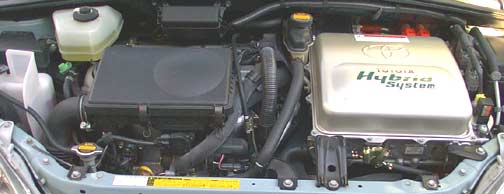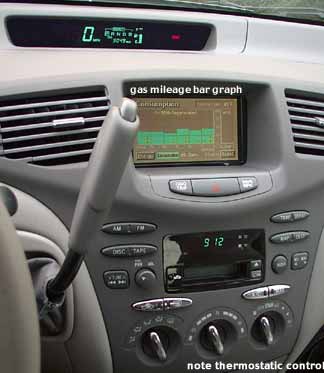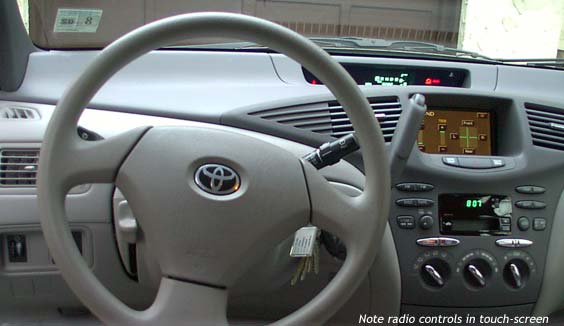The Prius really is not designed for a commute like mine - 50 miles of
high-speed freeway driving with a mile or so of city driving at one end and five
miles of normal-speed highway on the other. I generally reached about 41 mpg on
that route, driving at high speeds; that's roughly the same gas mileage I would
get in a new Corolla, a little above my own 1999 model. (That is in some ways
unfair, since the Prius is an automatic, while a Corolla needs a five-speed to
get 38-41 mpg; and because test cars nearly always get lower mileage than
ordinary cars, because they are not broken in as well). On the other hand, when stuck in traffic, I saw the gas mileage rise to 75
mpg, and others claim that you can actually get close to 100 mpg inching along
through heavy congestion. I've had jobs where I could probably have gotten a
good, steady 60 mpg in a Prius without much trouble, crossing the bridges into
New York City. The Prius would be a phenomenal city taxi, and we understand that
Yellow Cab of Vancouver, BC, is testing one for just that reason. The electric
engine should last pretty much forever, but whether the transmission (which
includes planetary gears and a chain drive) can hold up to steady city use over
the years is another question. We'd certainly love to see the thousands of city
cabs in New York, Vancouver, Chicago, etc. move from their current sub-20 mpg
mileage to 55 mpg! Once you understand the Prius' advantages in gas mileage and pollution (it is
a super ultra low emission vehicle), you can start to consider the mundane
questions: is the Prius practical as a daily driver? Is it comfortable and well
designed? In short, does it feel like a car on the bleeding edge, or is it
something you would like to buy and drive for the next ten years? Our answers
are mixed. First, the Prius has a fairly spacious interior, at least by Corolla/Civic standards. While
not exactly a Dodge Stratus or Toyota Camry (which sell for roughly the same
price), the Prius has decent room, and feels larger inside than it should
because of the "tall car" design. Passengers have plenty of headroom, and
legroom is adequate for most people. It will seat four comfortably and five if
the three in the back seat are small or don't mind physical intimacy. The trunk
can easily swallow up large packages and groceries, with a good, wide opening.
The trim looks good, without the patterned fabrics we've come to expect from
cars aimed at the youth market. Simple solid grays provide a classy appearance,
though close inspection shows that the trim is fairly cheap and lightweight.
That doesn't mean it won't last, and weight reduction is an important
contributor to gas mileage. The interior is comfortable, with seats that hold the driver well enough
during sharp turns, yet allow freedom of movement. There is no traditional
instrument panel, only a small electronic display in the center which is
surprisingly easy to get used to. We do miss an analog gas gauge, though, not to
mention a real temperature gauge; the Prius only has a blue "cold" icon, and the
gas gauge is "somewhat" accurate at best. (On moving back to an "ordinary" car, we realized Toyota is not kidding when
they say it is easier to use the center-mounted speedometer, since it is further
away from the driver and easier to quickly glance at while driving). There is also a touch-screen display which shows gas mileage, the power mode,
and radio controls; a navigation system is optional. Gas mileage is shown as an
average, an instant reading, and a bar chart for every five minutes the car has
been driven. The latter provides the best way to tune your driving to the car's
fuel economy needs, and would be welcomed on gasoline-powered vehicles as well.
The power mode is somewhat less useful; though the graphics are pretty, they
actually lag behind reality by about one second. When the engine runs because it
is cold, rather than to charge the batteries or create power, it still shows as
being off on the display. Likewise, the engine will keep running, even when the
car is stopped, after the "cold" icon disappears, which tells us that the
display and the engine are using different standards. Likewise, the screen is not an appropriate way to set the stereo controls; it
is a better system than the Cadillac Deville uses, since there are both
conventional radio controls and the touch screen, but it really requires too
much driver attention to do simple things like adjust bass and treble. The
stereo sound is much better than we expected from Toyota, not quite up to modern
premium stereo standards but good enough. It is far better than the Echo or
Corolla units. Other creature comforts are about what one would expect from an
upper-entry-level sedan: primitive cupholders, a capacious center console
storage unit, and a felt-lined cubby for change and whatnot. There is also a
small compartment in the center stack which may be taken up by a CD player.
Visibility is good in all directions, especially due to the high driving
position. Acceleration is moderately slow but very linear and predictable at low
speeds; however, because acceleration is limited by the computer rather than the
powertrain (the electric motor has a great deal of torque), it is practically
the same at high and low speeds. This means that mashing the pedal on the
highway has an immediate and surprising effect, making the Prius seem more
powerful than one would think. It makes passing very easy. Torque steer shows up mainly on initial acceleration. The Bridgestone Potenza
tires on our test car are a step above the standard car tire, and they help
handling quite a bit. However, this model tire tends to slip a bit at low
speeds, and is a little chirpy. The good news is that the Prius can easily be
whipped around sharp turns, even though the ride is very good for a car of this
size. It's not a sports car, but it plays one on TV - and most drivers will find
it to be more than good enough. The ride and handling are well balanced. The transmission, such as it is, can be intrusive at highways speeds, with
the car bumping a little as it recharges the batteries, moves the engine up a
notch, and otherwise fine tunes the power output. It feels as though it
is going in and out of gear on a regular basis (it isn't) because the power
drops for an instant every so often. Likewise, because the gas engine seems to
have a limited number of speeds, maintaining a set speed is somewhat difficult.
This may be why there is no cruise control, unusual in a $20,000 car [in some
areas, such as Canada, cruise control is standard]. Around town, though,
everything is smooth, and this is meant to be a town car, not a highway cruiser.
It does well enough for the occassional highway trip. The "stealth" mode, where only the batteries are used, is kind of fun if you
can stay in it, which requires painfully slow acceleration. Like it or not, over
about 35 mph, the gas engine is almost always on (while cruising; it always
shuts while decelerating). Even going to 25 in a reasonable time requires the
gas engine. On the other hand, the noise of the gas engine does not increase as
you accelerate; it stays at a constant speed, and the electric motor quietly
whines a little louder. It's a cool way to drive. As Bill wrote, "it is not an
electric vehicle and doesn't even play one on TV unless provoked. The battery
pack only provides enough energy for 2 to 3 miles at moderate below-40 mph
speeds." There is a B setting on the transmission for times when you are coming down a
steep hill and need the engine to brake; but we recommend only using it in
emergencies, since it takes more power. That isn't really explained in the
owner's manual. The brakes have a different feel; a light pressure on the brake pedal brings
normal-feeling braking, but move the pedal down just a little more and there is
an abrupt transition to the hydraulic brakes. Slow, early braking raises gas
mileage by allowing the generator to slow the car down. This doesn't require
much a change in driving habits, and is safer than waiting until the last
second. (Like the gas pedal, the brakes are a "fly by wire" system, where your
movement of the pedal is given to the computer, which then applies brakes or
power). After getting back into an "ordinary" Toyota, we realized that we had
become so accustomed to the brakes that we expected the Echo and Corolla to stop
the same way. Indeed, we missed the feel of the regenerative braking and the
knowledge that we were, in a sense, getting our gasoline back. The foot operated emergency brake makes sense in an automatic-transmission
car, but we don't like the push-once-to-set-and-again-to-release mechanism. It's
too easy to accidentally release and too hard to intentionally release compared
with a hand-operated release. If we were to compare the Prius to other cars based on the driving experience
alone, we would say it is overpriced by about $3,000, even if you consider the
three year bumper to bumper warranty (which includes normal maintenance and
loaner cars for VOR failures) and the eight year / 100,000 mile warranty for
hybrid components. However, its impact on the environment is minimal compared
even with most subcompacts, and if gas prices should rise, it would provide some
real long-term savings. Let us stand out from the Expedition-driving crowd, those who think that
bigger is always better, that there is unlimited clean air and gasoline, and say
that the Prius is worth the extra cash - especially if you do mostly city
driving. If, like me, you are on the highway most of the time, think about a
five-speed Corolla instead, if you can deal with the small interior. As for the
choice between Camry and Prius - we hate to say it, but the Prius wins, thanks
to its incredible efficiency and clean engine.
The hybrid-electric car is, we think, the
wave of the future. As the limitations of electric cars became clear - limited
range, heavy batteries, recharging, and the blatant inefficiency of using
power-line related energy loss - the advantages of the hybrids started to show.
No need to plug in; lighter batteries; and the efficiency of creating energy on
the spot, combined with the electric-car advantages of regenerative braking and
coasting, and the emissions-reducing potential to have engines that stay at a
single speed for relatively long periods of time. The Toyota Prius is the car of
the future, available from Toyota dealers today - or, if you live in Japan,
since late 1997. With an interior roughly the size of a Toyota Camry or Honda
Civic, the Prius achieves an amazing 55 mpg in the city - about 42 on the
highway. No, we didn't reverse those numbers - the Prius is built for
stop-and-go city and suburban traffic, and the slower you go, the higher your
mileage. City mileage is also greatly helped by the fact that, unlike "normal"
cars, the Toyota Prius regains some of your energy when you stop, taking what
would normally just be heat (and worn brake pads) and converting it back into
electricity. City roads also tend to have fewer hills.
 Actually, gas mileage varies dramatically based on your driving. If
you are easy on the gas and drive with slow, steady acceleration, you will do
much better. If you tend to do a lot of stoplight racing and drive at over 75
mph on the freeway, you will do much worse. Likewise, since the engine seems to
get about 10 mpg less when cold (since the gas engine is always running until it
warms up), if you live in the North and do a lot of small trips, gas mileage
will be relatively poor. Summer mileage is, we expect, substantially higher than
winter mileage, because the engine needs to run less to operate the heater and
keep the catalyst at operating temperature. Tire pressure also seems to be an
important factor - keep pressure at the recommended level, which we believe is
35 psi.
Actually, gas mileage varies dramatically based on your driving. If
you are easy on the gas and drive with slow, steady acceleration, you will do
much better. If you tend to do a lot of stoplight racing and drive at over 75
mph on the freeway, you will do much worse. Likewise, since the engine seems to
get about 10 mpg less when cold (since the gas engine is always running until it
warms up), if you live in the North and do a lot of small trips, gas mileage
will be relatively poor. Summer mileage is, we expect, substantially higher than
winter mileage, because the engine needs to run less to operate the heater and
keep the catalyst at operating temperature. Tire pressure also seems to be an
important factor - keep pressure at the recommended level, which we believe is
35 psi.
 Likewise, city police could easily switch over to cars like the Prius.
New York City cops used low-performance six cylinder engines for many years to
get better gas mileage, knowing that (a) they were capable of any speed you can
reach in the city, and (b) the police have a thing called radio. The
applications for delivery people are enormous - local pharmacies and couriers
could make great use of these cars. Indeed, the last electric truck in New York
City was a UPS truck, and it was only taken out of service because parts were no
longer available. Package delivery firms are again looking at electric and
hybrid powertrains, since they can recover most of the energy ordinary trucks
lose in stop-and-go traffic.
Likewise, city police could easily switch over to cars like the Prius.
New York City cops used low-performance six cylinder engines for many years to
get better gas mileage, knowing that (a) they were capable of any speed you can
reach in the city, and (b) the police have a thing called radio. The
applications for delivery people are enormous - local pharmacies and couriers
could make great use of these cars. Indeed, the last electric truck in New York
City was a UPS truck, and it was only taken out of service because parts were no
longer available. Package delivery firms are again looking at electric and
hybrid powertrains, since they can recover most of the energy ordinary trucks
lose in stop-and-go traffic. Sound reduction was mainly a matter of design, rather than heavy
insulation. That makes the Prius much lighter than the aforementioned Stratus,
while maintaining a quiet interior. The engine doesn't make much noise most of
the time - when on electric mode, it is silent - and wind noise seems to have
been cut back through aerodynamics. Overall, the interior feels to be about as
quiet as a Camry, though when at 4,500 rpm the engine is fairly loud. Most of
the time, drivers will not be calling for that much power; and the engineers may
have deliberately let the engine be noisy at maximum revs to remind drivers of
the consequences for fuel economy.
Sound reduction was mainly a matter of design, rather than heavy
insulation. That makes the Prius much lighter than the aforementioned Stratus,
while maintaining a quiet interior. The engine doesn't make much noise most of
the time - when on electric mode, it is silent - and wind noise seems to have
been cut back through aerodynamics. Overall, the interior feels to be about as
quiet as a Camry, though when at 4,500 rpm the engine is fairly loud. Most of
the time, drivers will not be calling for that much power; and the engineers may
have deliberately let the engine be noisy at maximum revs to remind drivers of
the consequences for fuel economy. The
climate control system is easy to use and figure out, with a simple dial control
to set the temperature (which is thermostatically controlled) and fan speed
(which can be set to "Auto" to best maintain the temperature). We wish all cars
had controls this easy to use, rather than the inane systems inflicted on us by
most automakers. Heat came fairly quickly; we did not have the opportunity to
test air conditioning, but we don't expect much based on other Toyotas. When the
heat is on maximum, an electric heater kicks in as well.
The
climate control system is easy to use and figure out, with a simple dial control
to set the temperature (which is thermostatically controlled) and fan speed
(which can be set to "Auto" to best maintain the temperature). We wish all cars
had controls this easy to use, rather than the inane systems inflicted on us by
most automakers. Heat came fairly quickly; we did not have the opportunity to
test air conditioning, but we don't expect much based on other Toyotas. When the
heat is on maximum, an electric heater kicks in as well. It takes
a moment after turning the key for the engine to start. The gas engine on our
model always started, even when the engine was warm, but others report that
sometimes they can start out on full-electric mode.
It takes
a moment after turning the key for the engine to start. The gas engine on our
model always started, even when the engine was warm, but others report that
sometimes they can start out on full-electric mode.
